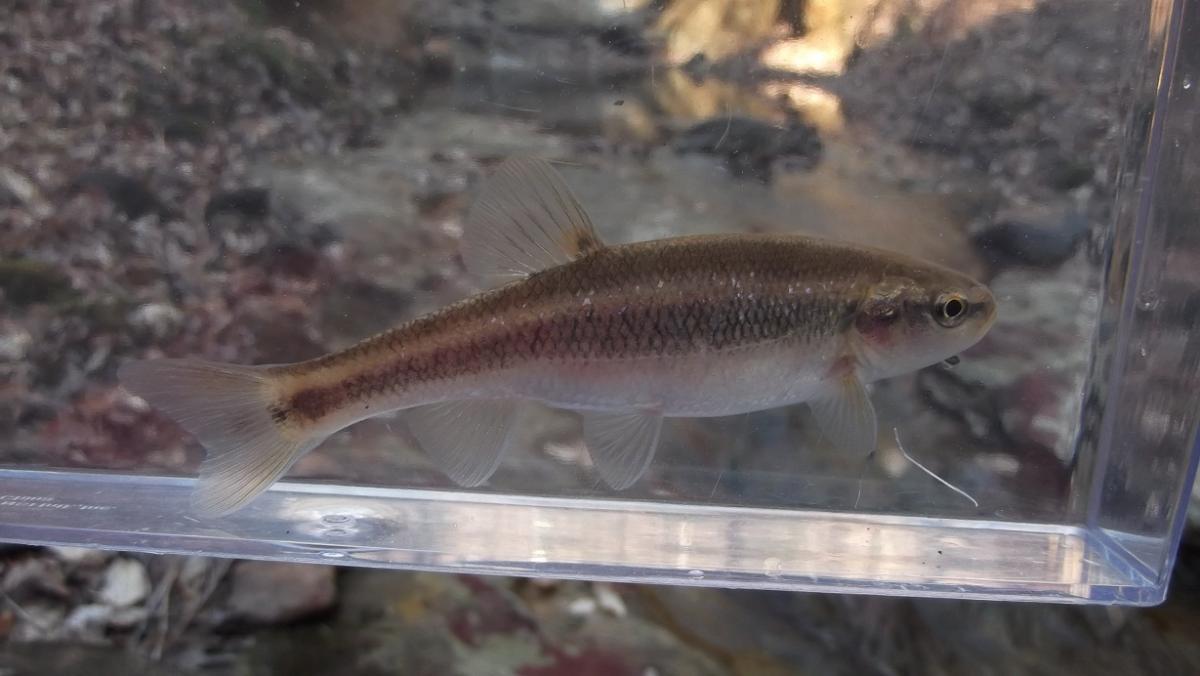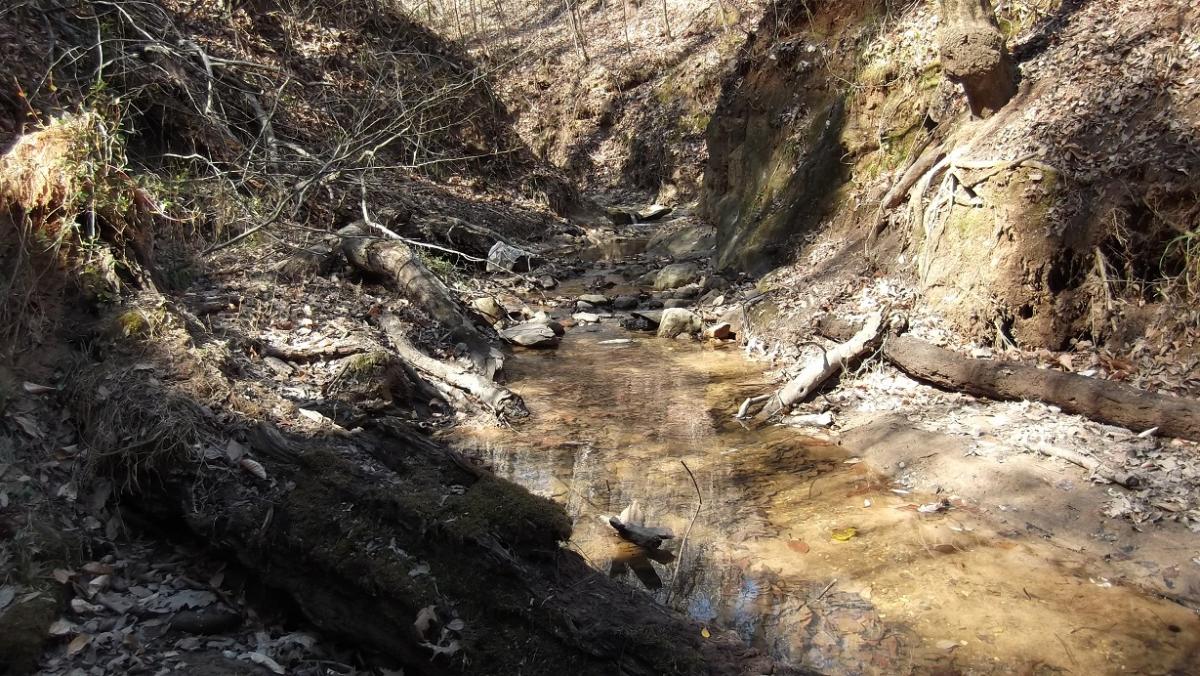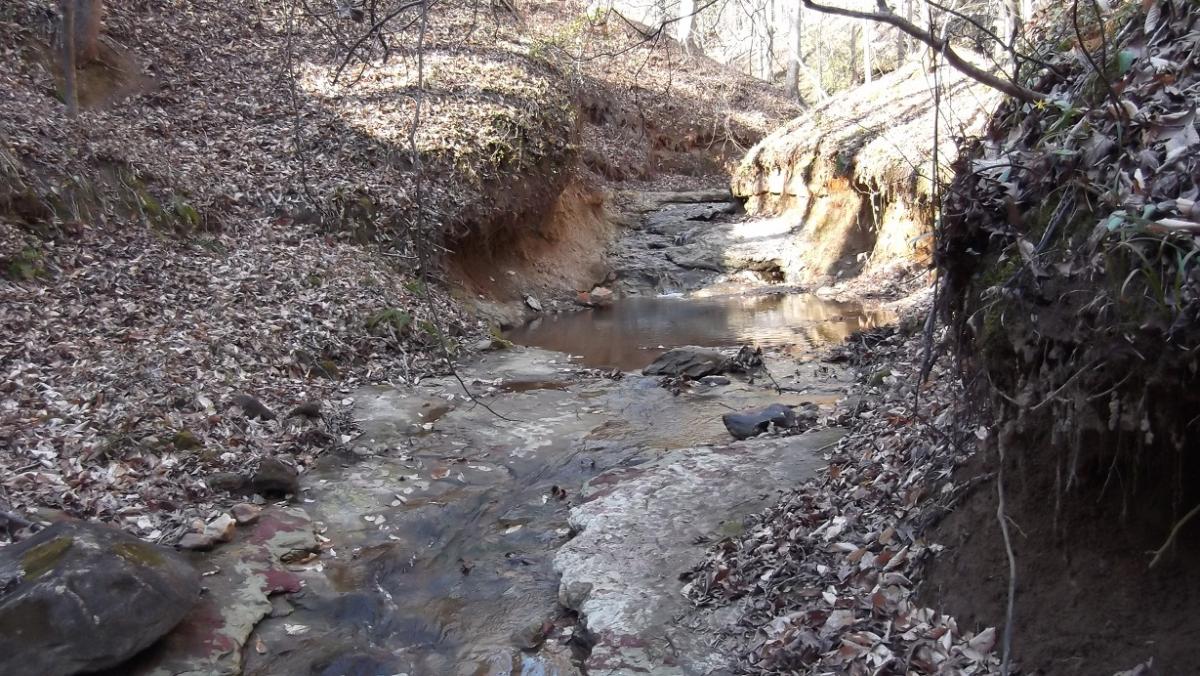Semotilus lumbee the Sandhills Chub, Spawning and Distribution
Started by
Guest_catfishcain_*
, Mar 16 2013 06:04 AM
18 replies to this topic
#1
 Guest_catfishcain_*
Guest_catfishcain_*
Posted 16 March 2013 - 06:04 AM
On Saturday March 9, 2013 I adventured off to the Cape Fear River right along the Cape Fear River Trail in Fayetteville, NC. The Cape Fear was several feet higher then I had expected and good shoreline was limited so I started at the mouth of a small creek flowing into the river and began to work my way up it. I had been to the same creek back in November and caught about 9 chub of which I believed to be the Sandhills Chub out of a nice pool that was maybe 2' deep, 8' wide, and maybe 10' long. I had taken pictures of around 5 of the chub and the pictures were okay but not great at showing all the rays in the dorsal fin. Since that day I had been hoping to return enable to catch a few more so i could take some better quality pictures. But as I was moving up the creek, every now and then I would spot around 3 to 5 fish that were about 1.5" long schooling in the runs that were typically about 2" to 3" deep. When I would spot them there always seemed to be a pool just upstream of them. So I didn't spend much time chasing after them and would just move straight up to the pool to target fish. Now out of the smaller pools I almost always caught S. lumbee that were around 2" and would see multiple other 2" S. lumbee darting up and down the pool. When viewed directly above the water they were pretty easy to distinguish from other species because the black stripe along their lateral line was so pronounced. As I continued up the creek to the largest pool in the stream I continued to see small schools of fish darting for cover. And whenever I would look under a nice sized rock in the hopes of finding a madtom, there was usually a chub that would dart out from under it. When I finally reached the largest pool in the stream I was able to catch two S. lumbee right off the bat that were both around 5". The first one which I believe to be a female had a fairly large belly, or at least it was larger than all the other S. lumbee that I had seen in the creek. And the pink coloration on the cheeks were espeecially stronger as well. After taking some pictures with the help of my photo tank I quickly released her. But after catching those two chubs and getting the pictures I was wanting, I stopped trying to catch any more chub because I didn't want to cause any undue stress to the S. lumbee if they were possibly getting ready to spawn since they have a very limited range in NC and SC. So I am assuming she had a belly full of eggs and was preparing to spawn.
Now when I tried to do some research on the internet in regards to the S. lumbee and when they are believed to spawn. The information would always say the spring but would more precisely say in April. Now the exact day I caught these S. lumbee was March 9th. I was wondering if anyone else has encountered S. lumbee that are possibly preparing to spawn as early as February to early March?
Also from the best data I could find on the range and distribution of the S. lumbee which came from "Distribution and Status of the Sandhills Chub, Semotilus lumbee, and Pinwoods Darter, Etheostoma mariae" by Rohde and Arndt as well as info from the NatureServe website. the only locations it has been recorded as in inhabiting based off NatureServe is the Upper Cape Fear River. On the map by Rohde and Arndt, the only collection sites from the Cape Fear River system were from the Deep River and from Drowning Creek. I was wondering has anyone else caught S. lumbee on the northern to northeastern most part of its documented range that would increase its known distribution? Going off the document by Rohde and Arndt, the northeastern most part of its known range (the document says southeastern but NC is the northern part of the Sandhills Chubs known range) but the northeastern most part of its range would be from the lower Drowning Creek. However, the creek on the north side of Fayetteville should extend its known northeastern range. The creek I caught it in appears to have no name, it is very short and is the creek flowing between Evans Lake and the Cape Fear River.
Now when I tried to do some research on the internet in regards to the S. lumbee and when they are believed to spawn. The information would always say the spring but would more precisely say in April. Now the exact day I caught these S. lumbee was March 9th. I was wondering if anyone else has encountered S. lumbee that are possibly preparing to spawn as early as February to early March?
Also from the best data I could find on the range and distribution of the S. lumbee which came from "Distribution and Status of the Sandhills Chub, Semotilus lumbee, and Pinwoods Darter, Etheostoma mariae" by Rohde and Arndt as well as info from the NatureServe website. the only locations it has been recorded as in inhabiting based off NatureServe is the Upper Cape Fear River. On the map by Rohde and Arndt, the only collection sites from the Cape Fear River system were from the Deep River and from Drowning Creek. I was wondering has anyone else caught S. lumbee on the northern to northeastern most part of its documented range that would increase its known distribution? Going off the document by Rohde and Arndt, the northeastern most part of its known range (the document says southeastern but NC is the northern part of the Sandhills Chubs known range) but the northeastern most part of its range would be from the lower Drowning Creek. However, the creek on the north side of Fayetteville should extend its known northeastern range. The creek I caught it in appears to have no name, it is very short and is the creek flowing between Evans Lake and the Cape Fear River.
#2
 Guest_catfishcain_*
Guest_catfishcain_*
Posted 16 March 2013 - 06:30 AM
This topic might need to go to Fish Groups under Minnows and Suckers. I don't know how I can change its topic. Sorry if its in the wrong forum location. At first I figured it would do better in the South Region because S. lumbee is only located in NC and SC and I posted it mainly to find out what other people have noticed in regards to spawning and distribution. Sorry about that.
#3
 Guest_Dustin_*
Guest_Dustin_*
Posted 16 March 2013 - 03:50 PM
I have caught lumbee but in the southern portion of their range in the Lynches and Wateree drainages. I would say you definitely have them there. The red spot is pretty unmistakable in the top fish. Hopefully Fritz will chime in at some point as well since this was his baby. The way they determined the boundary of the distribution was by looking at maps of the sediment composition. This seemed to work very well but that does not mean that the lines may not shift or be a little blurry at times. Very nice find there.
#4
 Guest_Dustin_*
Guest_Dustin_*
Posted 16 March 2013 - 03:55 PM
When they are spawning or possibly just when they get larger, they lose the spot altogether like the fish below.
http://gallery.nanfa...chub 2.jpg.html
http://gallery.nanfa...chub 2.jpg.html
#5
 Guest_gerald_*
Guest_gerald_*
Posted 17 March 2013 - 02:30 PM
I think those are probably creek chubs, not sandhills chubs, based on the dorsal spot, small scales, and dorsal rays (8 in 1st pic, can't tell if its 8 or 9 rays in 2nd pic), and also where you caught it -- a short, tiny creek close to the Cape Fear River. For sandhills chubs in the Cape Fear basin, try the upper tribs of Rockfish Creek and Little River west and northwest of Fayetteville, along the western edge of Cumberland Co and adjacent Moore and Hoke counties.
#6
 Guest_catfishcain_*
Guest_catfishcain_*
Posted 18 March 2013 - 07:47 AM
That first ray that only goes up half way, does that ray not count? On the link posted by Dustin the first and second ray are close like on my pics. Granted in that pic the ray goes all the way to the top of the fin with the other tall rays. From all the chub I caught out of that stream the dorsal spot was light to absent but there was always an orange spot there. Alot of the chubs also had rays that would split up to 4 times, either near the top of the fin or near the bottom.
#7
 Guest_gerald_*
Guest_gerald_*
Posted 18 March 2013 - 09:44 AM
Walter - Count fin rays at the base of the fin where it joins the body. It's easy to mistakenly count the posterior dorsal ray as two rays, since the main branches are separate all the way to the base, but they usually do join together as one ray at the body. And yes you're right if there's a thin half-ray at the front pressed up close against the first full-length ray, it doesn't count (in minnows). HOWEVER in fish that normally have a short first ray separated from the next ray by a membrane, all the way to the body, then you DO count it. Page 19 in Menhinick's NC Fishes explains it well.
My two books (Menhinick's NC Fishes and Rohde's SC fishes) both say that sandhills chub does not have a distinct dorsal spot as creek chubs do. I've only seen a couple sandhills chubs in my life (in Moore and Richmond Co's long ago) and didn't see any dorsal spot on those, but I've seen lots of small creek chubs with a pale orange spot, sometimes barely visible.
My two books (Menhinick's NC Fishes and Rohde's SC fishes) both say that sandhills chub does not have a distinct dorsal spot as creek chubs do. I've only seen a couple sandhills chubs in my life (in Moore and Richmond Co's long ago) and didn't see any dorsal spot on those, but I've seen lots of small creek chubs with a pale orange spot, sometimes barely visible.
#11
 Guest_catfishcain_*
Guest_catfishcain_*
Posted 20 March 2013 - 11:50 AM
Thanks for all the info. And that is very helpful to know about counting dorsal rays. Sorry I didn't respond sooner after my second reply, I was receiving emails letting me know there were new posts but haven't got any after I posted twice.
There really are not many pictures of the Sandhills Chub on the Internet.
Hopefully this summer I will be able to afford a car again and can hit up some waters that are more then just a bike rides distance away. And actually catch me one of those Sandhills Chubs. Living in the barracks on Bragg with work just across the street I've been able to pay off my debt and help family with out having to have a car.
There really are not many pictures of the Sandhills Chub on the Internet.
Hopefully this summer I will be able to afford a car again and can hit up some waters that are more then just a bike rides distance away. And actually catch me one of those Sandhills Chubs. Living in the barracks on Bragg with work just across the street I've been able to pay off my debt and help family with out having to have a car.
#13
 Guest_fritz_*
Guest_fritz_*
#16
 Guest_gerald_*
Guest_gerald_*
Posted 21 March 2013 - 11:02 AM
This thread makes me wonder how many other undescribed Semotilus are lurking out there in small pockets throughout the creek chub's huge range. You'd expect genetic divergence and speciation to be pretty common in a headwater specialist. Low-diversity 1st order creeks aren't usually a high priority for fish sampling.
#17
 Guest_catfishcain_*
Guest_catfishcain_*
Posted 21 March 2013 - 11:33 AM
Gerald it's funny cause I've been wondering that myself lately. I'd have to look again to make sure but I believe a few of the Creek Chubs metrics (think that's the word) like lateral line scale count has a pretty large range on how many scales they have. I think it was the anal fin as well that could vary by one ray. I think that was the fin. I wonder if higher scale counts compared to lower scale counts could geographically be identified. And the same with the fins. If enough people across North America went to their local waters and examined the creek chubs from the varies river systems near by. And then they all shared that info (with possibly good guality pictures of those creek chubs) then it could help narrow down certain river systems that should be focused on for a more detailed examination. I think that would be a great thread/forum on this site. I know I'd be very interested in that information.
Reply to this topic
0 user(s) are reading this topic
0 members, 0 guests, 0 anonymous users












